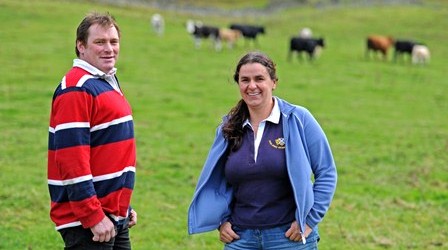THE benefits and challenges of calving heifers at two years old is being weighed up at Hundleshope, the Peebleshire monitor farm.
Monitor farmers Ed and Kate Rowell, run a suckler herd totalling approximately 70 breeding females on the 1,800 acre (729 ha) farm, a few miles south of Peebles.
Hundleshope, on the Haystoun Estate, is one of the most recent additions to the network of Quality Meat Scotland (QMS) monitor farms throughout Scotland.
The Rowells replacement heifers are either home-bred or purchased beef cross dairy heifers.
These replacement heifers have been either artificially inseminated or bulled, to calve at two years of age.
The Rowells have experienced difficulties getting some of the first calved heifers back in calf with their second calf. Of the total of 70 females which were bulled in 2012, pregnancy diagnosis revealed 12 not in calf. Of these 12, four were first calvers.
Bulls go into the main herd in July, for 12 weeks. This year the majority of cows calved in the second and third cycles.
Gavin Hill, senior beef specialist at SAC Consulting, a division of SRUC, Scotland’s Rural College recommends aiming to calve heifers a month or two earlier than the main herd.
He said: “This gives them some extra time to recover, and will improve their chances of going back in calf, to calve with the main herd in following years.”
Mr Hill added: “Give replacement heifers no more than a couple of cycles to take the bull. You only want to bring naturally, highly fertile females into the herd, so don’t hesitate to cull any not in-calf after eight weeks of opportunity.
“Also, your priority is a live calf, along with a fit and healthy heifer post-calving, so use only easy calving bulls over heifers.”
The standard industry advice recommends using weight as a guide to determine heifer maturity at bulling, with a minimum of 65 per cent of mature cow weight, i.e. for a 600 kg mature cow, minimum heifer bulling weight would be 390 kgs.
Mr Hill recommended exercising some caution, explaining: “If heifers are to be calved at two, they need to have scale as well as weight. While calving at two looks right on paper, it doesn’t suit everybody.
“So while a heifer’s weight might be 65 per cent of her projected mature weight, it’s important you still use your eye to assess her size and scale to satisfy yourself whether or not she really does look capable.”
He added: “The weather of recent years has challenged some herds calving heifers at two, with some of these calved heifers experiencing fertility and condition problems.
“So it’s worth keeping your first and second calved heifers in a separate group, giving them a little bit of extra food. While they’re rearing their calves, they’re also still growing themselves, and it’s asking a lot of them to do all that and go back in calf.”
The next Peebleshire monitor farm meeting will be held on Tuesday, 27th August, at 1pm.
For further information, please contact either of the joint facilitators – Jennifer Brown tel: 01835 823322 or email: jennifer.brown@sac.co.uk or Chris McDonald tel:0131 535 3436 or email Chris.mcdonald@sac.co.uk.
For general information on monitor farms, plus detailed reports of meetings: www.qmscotland.co.uk/monitorfarms
MEDIA RELEASE posted by QMS. You too can post media releases (aka press releases) on this site. For more information, email here.
Contact: Carol McLaren
Email: cmclaren@qmscotland.co.uk
Website: http://www.qmscotland.co.uk







